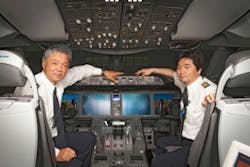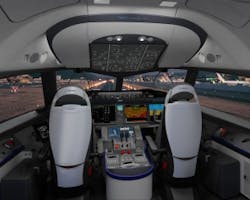Boeing 787 Avionics Overview
Posted by John McHaleSEATTLE, 17 June 2011. The Boeing 787 Dreamliner -- one of the most promoted and hyped aircraft in the history of aviation -- will be on display at the Paris Air Show June 20 to 24, and the new passenger jet's advanced avionics and fight deck will be one of the show's major attractions. The new jet should be in operation before the year is out with its launch operator, All Nippon Airlines (ANA), having completed flight training and final validation of the aircraft. The 787 avionics systems and components have been set for some time, but as the 787 nears deployment it might be a good time for a refresher on what is in the cockpit of Boeing's newest jet.Rockwell Collins in Cedar Rapids, Iowa, provides the flight deck and most of the aircraft's avionics systems, says a Rockwell Collins spokeswoman. None of the avionics are specifically unique to the 787, but many of the systems such as the integrated surveillance system (ISS) are being leveraged for use in business jets as well as other commercial aircraft, she adds.Rockwell Collins provides the flight deck display system, pilot controls, crew alerting system, the core network cabinet, communication and surveillance systems, and the common data network for the 787's Common Core System. The electronic flight bag (EFB) used on the 787 comes from Astronautics Corporation of America in Milwaukee, Wis. Honeywell Aerospace in Phoenix provides the flight management system (FMS), Earth reference system (inertial navigation), integrated navigation radio, long range radio altimeter, Automatic Director Finder (ADF), DME, crew information system/maintenance system, and communication management function, says Michael Carroll, director of Boeing Business Development at Honeywell.All three companies will be in France next week with stands at the Paris Air Show at Le Bourget airport from June 20th through 24th -- Rockwell Collins in Hall 4 booth A18, Astronautics in Hall 6 booth A32, and Honeywell in Hall 3, booth B56.Rockwell Collins avionics on the 787The Rockwell Collins integrated display system has five 15.1-inch diagonal liquid crystal displays (LCDs), plus dual LCD head-up displays (HUD). The company's head-up guidance system (HGST) provides advanced navigation, primary flight, and crew alerting functionality. The HGS uses cursor control devices plus a multi-function key pad to do data entry and retrieval.
The Rockwell Collins SAT-2100, VHF-2100, and HFS 900D form the communications systems for the 787. A lighter VHF-2100 is VDL Mode 2 capable with evolution to VDL Mode 3 and 4. The SAT-2100 supports the International Civil Aviation Organization's (ICAO's) safety services, as well as three voice communication channels with a roadmpa to future Inmarsat Swift Broadband high-speed data technology. Also included in the communications package, is a digital flight deck audio system plus a cockpit voice and flight data recorder system. The company's developed ISS uses the Rockwell Collins MultiScan Hazard Detection System, Mode S surveillance, traffic alert and collision avoidance, and terrain awareness and warning technology. The 787 pilot controls use a control stand that has auto throttles, and pitch, roll, yaw, and primary flight controls. The controls also interface to the 787's fly-by-wire systems. The pilot controls are based on the 777 system to give provide a similar look and feel to the pilots.The Core Network, which is standard on the 787, uses computing servers and networks based on commercial open standards. It also has a variety of third-party applications to manage the onboard data flow to improve airline efficiency. The Common Data Network (CDN from Rockwell Collins is a, bi-directional copper and fiber optic network that utilizes ARINC 664 standards and protocols to manage the data flowing between the 787's onboard systems. It is based on Ethernet technology and enabled for avionics systems. The CDN has higher data rates, expanded connectivity, and reductions in overall aircraft weight when it is contrasted with point to point topologies, Rockwell Collins officials say.Astronautics EFBAccording to Eyton Zelazo, business development manager for Astronautics, each 787 airplane contains has two Astronautics' EFBs onboard, that consist of a dual processor computer and display. The EFB hosts applications that provide pilot information via touch screen and bezel in a user-friendly digital format, he says.The EFB contains dual processors and dual hard drives to implement a hardware partition between the certified and uncertified applications, Zelazo says. The EFB has display unit and an electronics unit connected via fiber optic connection between the EU and DU, and between both DUs in a dual system configuration.Astronautics has supplied these EFBs for other Boeing aircraft as well including the 747-8, 777, and 737. The ones on the 777 have been flying for more than two years now with "excellent reliability," Zelazo says.Honeywell FMSThe Honeywell FMS is designed to be compatible with technology from the Federal Aviation Administration's (FAA's) Next Generation Air Transportation System (NextGen), Carroll says. It has capability for required navigation area navigation (RNP RNAV) approaches such as RNP by FMS leg from the navigation database and RF legs -- or fixed radius arcs without distance measuring equipment, he adds.The FMS also has RNP 0.1, RNP Holds integrated approach navigation; navigation performance scales, GPS landing system (GLS) approaches, Controller Pilot Data Link Communications (CPDLC), Future Air Navigation System (FANS) 1/A Data Link, ADS-A, AFN, FANS 2 Data Link, Required Time of Arrival; RNP for Direct Approaches (DPs), Enroute; fixed radius turns on airways; noise abatement departure procedures; constant descent arrivals/approaches, and integrated speed management for approach/ missed approach.

